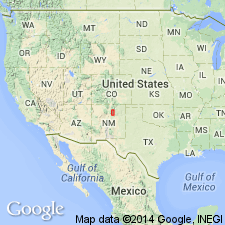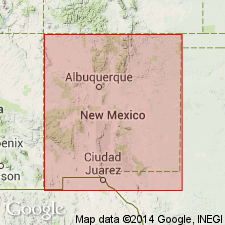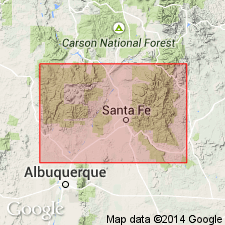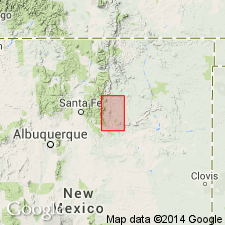
- Usage in publication:
-
- Tererro formation*
- Modifications:
-
- Named
- Dominant lithology:
-
- Breccia
- Limestone
- Siltstone
- AAPG geologic province:
-
- Palo Duro basin
- San Luis basin
- Las Vegas-Raton basin
- Estancia basin
Summary:
Named for Tererro, San Miguel Co, NM, Palo Duro basin, where 118-ft-thick type locality designated 75 yds north of Holy Ghost Creek, on slope above and slightly north of quarry. Unconformably overlies Espiritu Santo formation (new), between late Precambrian and Early Mississippian in age; unconformably underlies Sandia formation of Pennsylvanian age. Divided into (ascending, all new): 1) Macho member, massive, ledge-forming limestone breccia, 30 ft thick, forming a rounded ledge with a notch at top; erosional unconformity, then 2) Manuelitas member, light- to medium-gray, fine- to coarse-grained calcarenite, limestone-pebble conglomerate, and finely crystalline limestone, 39 ft thick, some beds with chert bodies; unconformity follows, then 3) Cowles member, light-grayish-yellow to light-olive-yellow, cross-bedded, silty calcarenite and calcareous siltstone, 50 ft thick. Ranges in thickness from a trace to 130 ft in southern Sangre de Cristo Mountains, and from 6 to 8 ft farther north. Tererro present throughout most of Sangre de Cristos (except along western margin, where rocks have been cut out or concealed by overthrust rocks of Precambrian age) in Taos, Mora, San Miguel, and Santa Fe Cos, NM, in San Luis, Las Vegas-Raton, Palo Duro, and Estancia basins. Present in Rincon, Santa Fe, Taos, and western part of Truchas Ranges. Faunas in Manuelitas member indicates Early Mississippian age for that part of the formation. Measured sections.
Source: GNU records (USGS DDS-6; Denver GNULEX).

- Usage in publication:
-
- Tererro Formation
- Modifications:
-
- Age modified
- AAPG geologic province:
-
- San Luis basin
- Estancia basin
- Palo Duro basin
- Las Vegas-Raton basin
Summary:
Age of Tererro Formation modified. Age of Manuelitas Member of Tererro Formation given by Baltz and Read (1960) as Early Mississippian, based on faunule found in Manuelitas Member; in this report, species of ENDOTHYRA have been collected from all three members of Tererro, studied by Zimmerman of Sun Oil Co Research Laboratory, and found to be definitely Meramecian age. Since none of the fossils (primarily brachiopods) listed by Baltz and Read (1960) were identified with certainty and were poorly preserved as well, the well-preserved endothyrid faunas of this report are believed to provide a more reliable indication of probable age. The entire Tererro Formation is therefore best considered to be of Meramecian (Late Mississippian) age, as previously proposed by Armstrong (1958), who studied endothyrid faunas from various Mississippian localities in northern NM. Tererro present throughout most of Sangre de Cristo Mountains (except along western margin, where rocks have been cut out or concealed by overthrust rocks of Precambrian age) in Taos, Mora, San Miguel, and Santa Fe Cos, NM, in San Luis, Las Vegas-Raton, Palo Duro, and Estancia basins. Present in Rincon, Santa Fe, Taos, and western part of Truchas Ranges. Tererro unconformably overlies Espiritu Santo Formation (revised, redescribed, and age modified); unconformably overlain by Early Pennsylvanian sandstones, shales, and thin limestones. Geologic map, sections.
Source: GNU records (USGS DDS-6; Denver GNULEX).

- Usage in publication:
-
- Tererro Formation*
- Modifications:
-
- Revised
- Age modified
- AAPG geologic province:
-
- Las Vegas-Raton basin
- Palo Duro basin
- San Juan basin
Summary:
Tererro Formation revised: assigned as upper of two formations--Espiritu Santo and Tererro--of Arroyo Penasco Group (here raised in rank to group) and divided into the following members (ascending): Macho, Turquillo (newly named this report), Manuelitas, and Cowles Members. Present in report area of north-central NM in sections measured at Tererro, Pecos River Canyon, and Jack's Creek, all in southern Sangre de Cristo Mountains, San Miguel Co, Palo Duro basin; Coco City, southern Sangre de Cristo Mountains, Mora Co, Las Vegas-Raton basin; Mora Gap, Mora Co, Las Vegas-Raton basin; Turquillo and Lujan Canyon, Rincon Range, Mora Co, Las Vegas-Raton basin. Only Manuelitas Member of Tererro recognized in Nacimiento Mountains, Sandoval Co, San Juan basin; Tererro not present in Jemez or Sandia Mountains. Overlies Espiritu Santo Formation of Arroyo Penasco unconformably; underlies Log Springs Formation in western part of area, Nacimiento Mountains, Sandoval Co, San Juan basin; to east in southern Sangre de Cristo Mountains underlies La Pasada Formation (to south) and Flechado Formation (to north). Age of Tererro modified from just Meramecian (Sutherland and others, 1963) to Meramecian and Chesterian (Late Mississippian) based on microfossils; Macho, Turquillo, and Manuelitas Members are Meramecian; Cowles Member (at top) is Chesterian. Measured sections, correlation chart. Depositional cycles discussed.
Source: GNU records (USGS DDS-6; Denver GNULEX).

- Usage in publication:
-
- Tererro Formation*
- Modifications:
-
- Areal extent
- AAPG geologic province:
-
- Las Vegas-Raton basin
- Palo Duro basin
Summary:
Mapped undifferentiated as upper formation of Arroyo Penasco Group in southeastern Sangre de Cristo Mountains, Mora and San Miguel Cos, NM, Las Vegas-Raton and Palo Duro basins. Widely distributed in mapped area, though absent locally due to erosion or nondeposition. Consists of three members, in ascending order, Macho, Manuelitas, and Cowles. Members are separated by erosional unconformities. (Turquillo Member of Armstrong and Mamet, 1974, not used). Thickness ranges from 3 ft near Montezuma to 90 ft east of Rociada. Macho consists of massive, ledge-forming limestone breccia derived from upper parts of underlying Espiritu Santo of Arroyo Penasco; Manuelitas consists of calcarenite, limestone-pebble conglomerate, and crystalline limestone; and Cowles consists of basal silty to sandy calcarenite and an upper calcareous siltstone and interbedded silty limestone. Unconformably overlies Espiritu Santo of Arroyo Penasco; unconformably underlies Sandia Formation with erosional contact. Measured sections; chart showing comparison of previous nomenclature; fossil list. Assigned Late Mississippian (Meramecian and early Chesterian) age based on microfossils reported by Armstrong and Mamet (1979).
Source: GNU records (USGS DDS-6; Denver GNULEX).
For more information, please contact Nancy Stamm, Geologic Names Committee Secretary.
Asterisk (*) indicates published by U.S. Geological Survey authors.
"No current usage" (†) implies that a name has been abandoned or has fallen into disuse. Former usage and, if known, replacement name given in parentheses ( ).
Slash (/) indicates name conflicts with nomenclatural guidelines (CSN, 1933; ACSN, 1961, 1970; NACSN, 1983, 2005, 2021). May be explained within brackets ([ ]).

